'Alba' is a popular variety with "long white tubes and bright scarlet petals". People always say plants with names enclosed by single quotes--cultivars, vars--don't don't grow true from seed. That ignores the possibility of a plant being misnamed. I understand there is some question about that with regard to F. boliviana 'Alba'. Some people say it grows true from seed and others say it does not.
It's certainly easy to grow from seed, and my little experiment is about to produce results.
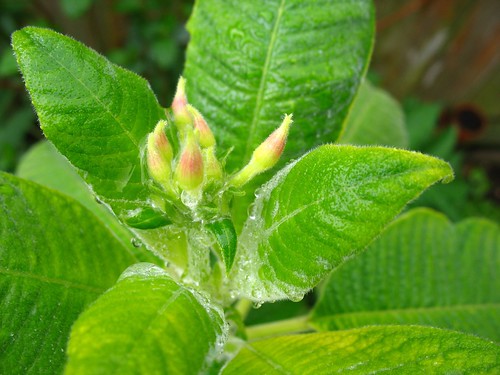
I grew several of these a year-and-a-half ago and gave most of them away. I put one in my community garden plot last year, but a gopher killed it just as it was about to flower. The buds looked promising to me--I saw scarlet tips enclosed in a white tube. Here is one of the two that I kept, and it's about to flower. We'll see what happens.
Planted in the ground, these shrubs attain tree-like proportions which I can't afford in my small space, so I've got this one in a large pot.
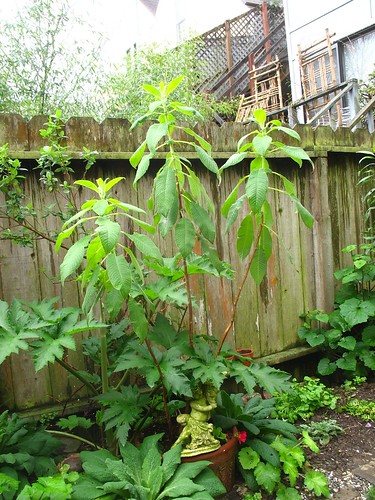
Planted in the ground behind the pot is Heracleum lanatum, Cow Parsnip, a western native from seasonally damp, shady aspen forests. The foliage fills in space between the fuchsia stems.
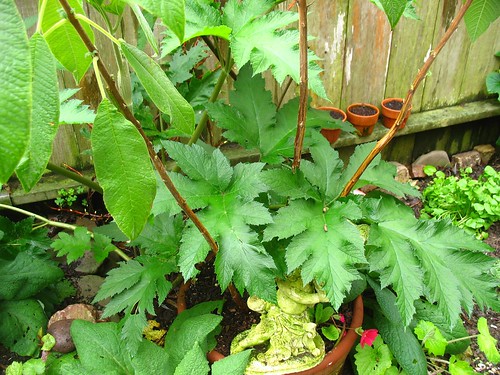
I grew this from seed too, which was also very easy.

A cherub from my grandmother's house shares the fuchsia pot.
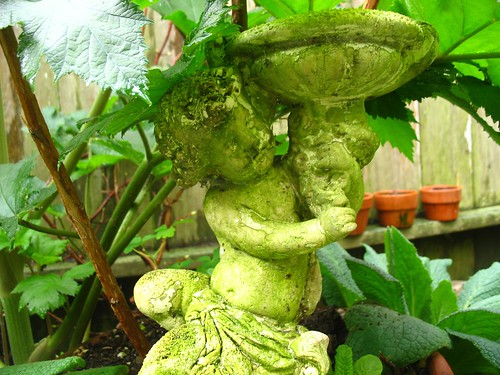
Also behind the fuchsia, and behind the cow parsnip, is Calif. native var. Ceanothus 'Ray Hartman', right about to pop.
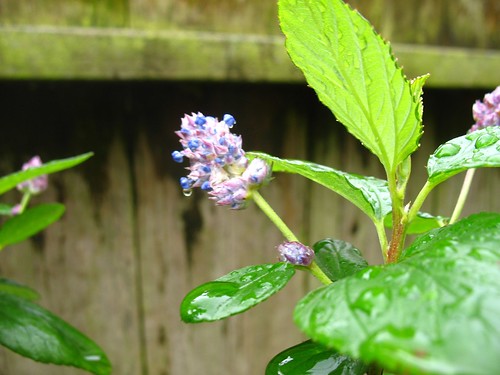
Speaking of natives and names, Bart O'Brien has an editorial in the
"Some of our former Rhamnus are now recognized as species of Frangula. California will no longer have any native Coreopsis species as these have all been transferred to the genus Leptosyne. Our palo verdes are no longer in the genus Cercidium as they have been incorporated into the genus Parkinsonia. It appears likely that we will no longer have any native species left in the genus Leptodactylon as California's are almost certainly moving into the genus Linanthus--and a number of Linanthus species are moving into the genus Leptosiphon. Some of our native Aster species, including the well known A. chilensis, have been moved to the genus Symphyotrichum..."The editorial is subtitled "The Need for a Standardized List of Common Names for California's Native Plants".
Heh!

3 comments:
When u saw Alba, i was hoping you'd have pictures of Jessica Alba.
Cow parsnip? looks cool. Change the name and it'd be a big seller!
Heh indeed!
Is there a CNPS seed exchange? I don't really have the money to join, but I might be able to retionalize it if there were a seed exchange.
You have almost universally good garden pictures.
About those common names - there's no real refuge there either. Consider the situation of the wine varietal, Valdiguié
From wikipedia, "Valdiguié is a red wine grape grown primarily in the Languedoc-Roussillon region of southern France, where it is generally known by the alias Gros Auxerrois. In Gaillac it is known as Brocol, and in California it has been known as Napa Gamay or Gamay 15. Until 1980 Napa Gamay was believed to be the Gamay of Beaujolais,[1] but following genetic analysis the name 'Napa Gamay' has been banned from U.S. wine labels since January 1999. [2] Confusingly, both the Pinot Noir clone Gamay Beaujolais and 'Napa Gamay' could be labelled 'Gamay Beaujolais', a name banned on labels from April 2007."
Post a Comment